‘Should you exercise during your period?’
For generations, women have been told to slow down, skip workouts, and put movement on pause during their menstrual cycle. But is that what your body truly wants?
The female body doesn’t work on a 24-hour clock like most men’s bodies.
It works on a roughly 28-day cycle, orchestrated by four hormonal phases: menstrual, follicular, ovulation, and luteal. Each phase brings its own set of physical, emotional, and metabolic changes. That’s why syncing your exercise and menstrual cycle isn’t just a wellness trend.
But first, let’s understand the basics.
Understanding Your Menstrual Cycle & Energy Levels
The menstrual cycle governs so much of how women feel, move, think, and show up in the world. For too long, we’ve seen it as an inconvenience, something to hush away and power through.
But the truth?
It’s a rhythm. A natural, hormonal symphony that, when understood, can guide us into better decisions, especially around exercise during your period and throughout the month.
There are four phases in the menstrual cycle:
- Menstrual phase
- Follicular phase
- Ovulation phase
- Luteal Phase
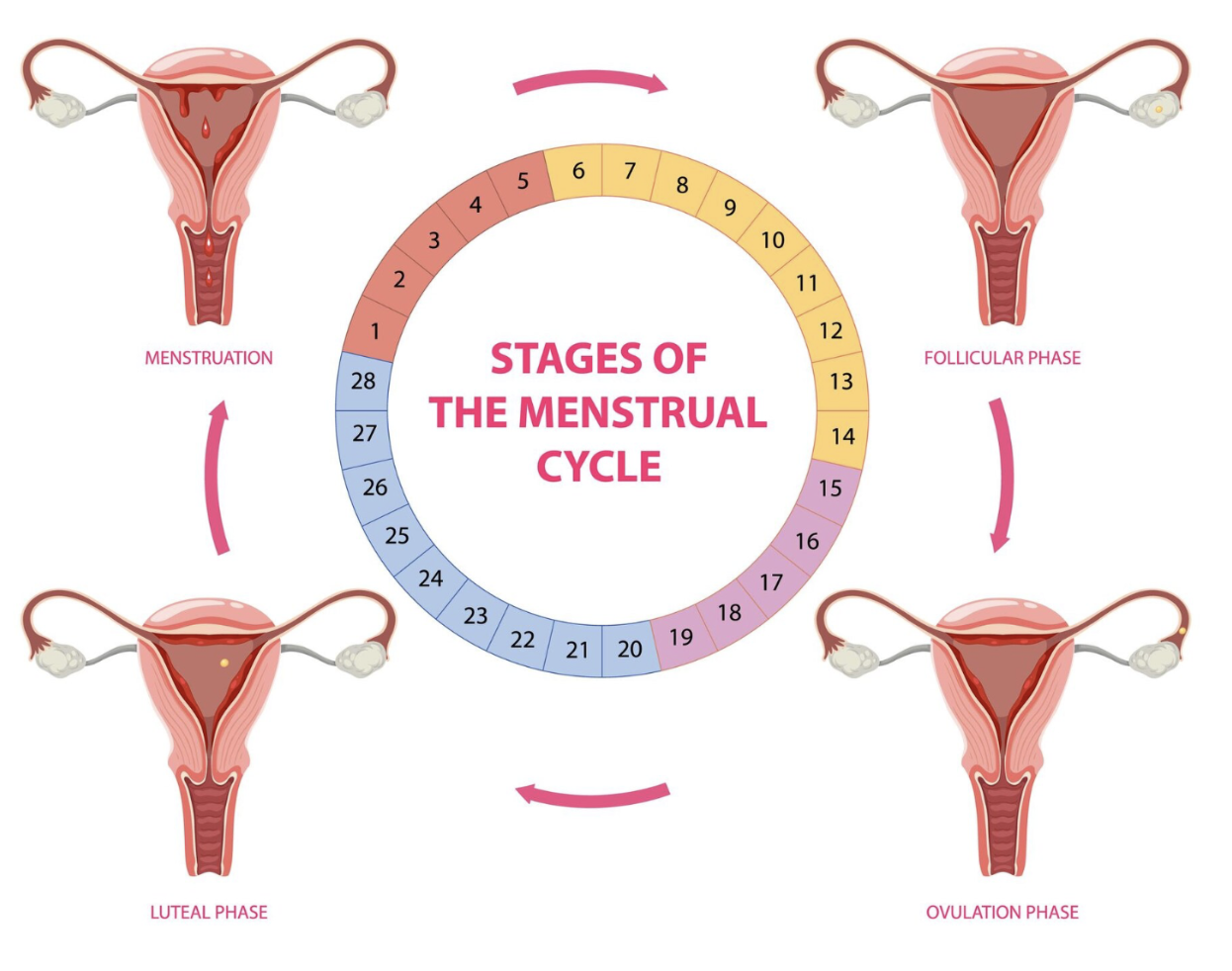
The following happens in each phase:
- Hormonal Fluctuations and Energy Availability: During the menstrual phase, the reproductive hormones, estrogen and progesterone levels are at their lowest. This often leads to a dip in energy, increased sensitivity to pain, and changes in metabolism.
- Estrogen and Strength Gains: As the cycle moves into the follicular phase, estrogen levels start to rise. This hormone is not just about reproduction; it plays a role in increasing muscle mass, improving insulin sensitivity, and enhancing recovery.
- Ovulation and Peak Performance: Around the time of ovulation, estrogen peaks, and there’s a brief surge in testosterone, contributing to heightened strength, coordination, and stamina. This is a powerful time to take on new challenges in your menstrual cycle workout.
- Luteal Phase and The Slowdown: As progesterone rises post-ovulation in the luteal phase, many women experience a natural decline in energy, mood changes, and even bloating or discomfort.
So, why does all this matter?
Because when you understand what’s happening internally, you stop fighting your body and start working with it. Exercise doesn’t have to look the same every day. It’s not about pushing through; it’s about tuning in.
In the end, exercise during your period and across your cycle is less about ‘doing more’ and more about doing what’s right for your body at the right time. And when we learn how to move with the wisdom of our own biology, everything begins to align—energy, mood, performance, and even emotional balance.
Let this be your permission slip: your body isn’t unpredictable; it’s cyclical. And that’s your superpower.
Why Physical Activity Matters During Menstruation?
When you look at the physiology of the menstrual phase, what’s actually happening is a withdrawal of both estrogen and progesterone. This shift can trigger uterine muscle contractions (cramps), a dip in serotonin levels (which impacts mood), and a subtle inflammatory response as the endometrial lining sheds. Now, all of this can feel uncomfortable and understandably so.
But this discomfort doesn’t necessarily mean the body needs to shut down. Instead, it could be inviting a gentler form of movement. And that’s where exercise during periods gains relevance, not as a forced routine, but as a mindful response to what your body is asking for.
Let’s look at the evidence:
- A comprehensive review by Daley (2009) published in the Journal of the Royal College of General Practitioners found that regular aerobic activity significantly reduced the severity of menstrual cramps (primary dysmenorrhea).
The underlying mechanism?
Increased endorphin production, improved pelvic blood flow, and better oxygenation of uterine tissues—all of which help reduce pain.
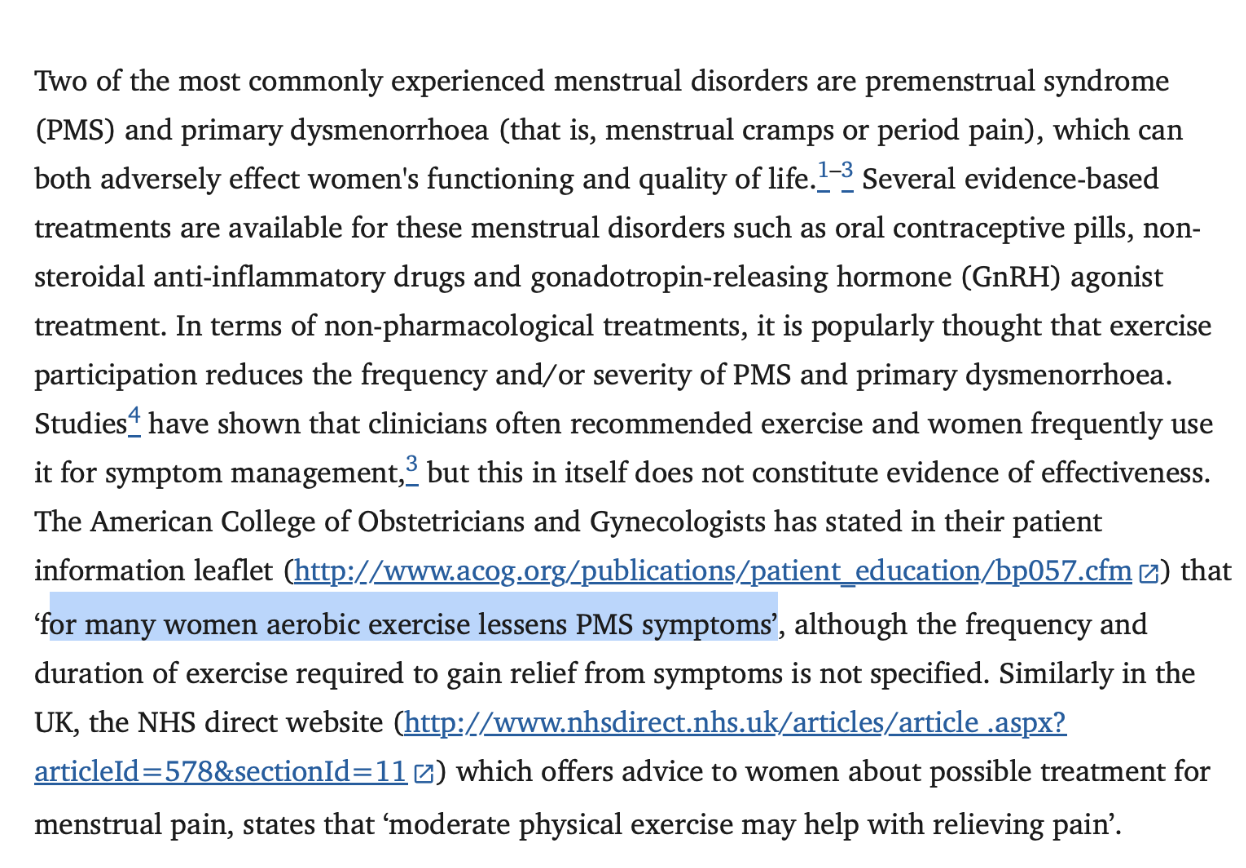
- Similarly, a study published in the Journal of Family and Reproductive Health explored the effects of a 3-month aerobic exercise regimen on women with painful periods. The results were striking: women who engaged in consistent movement reported less pain, lower PMS symptom intensity, and even reduced menstrual blood volume, a testament to how the body benefits from being gently activated rather than immobilized.
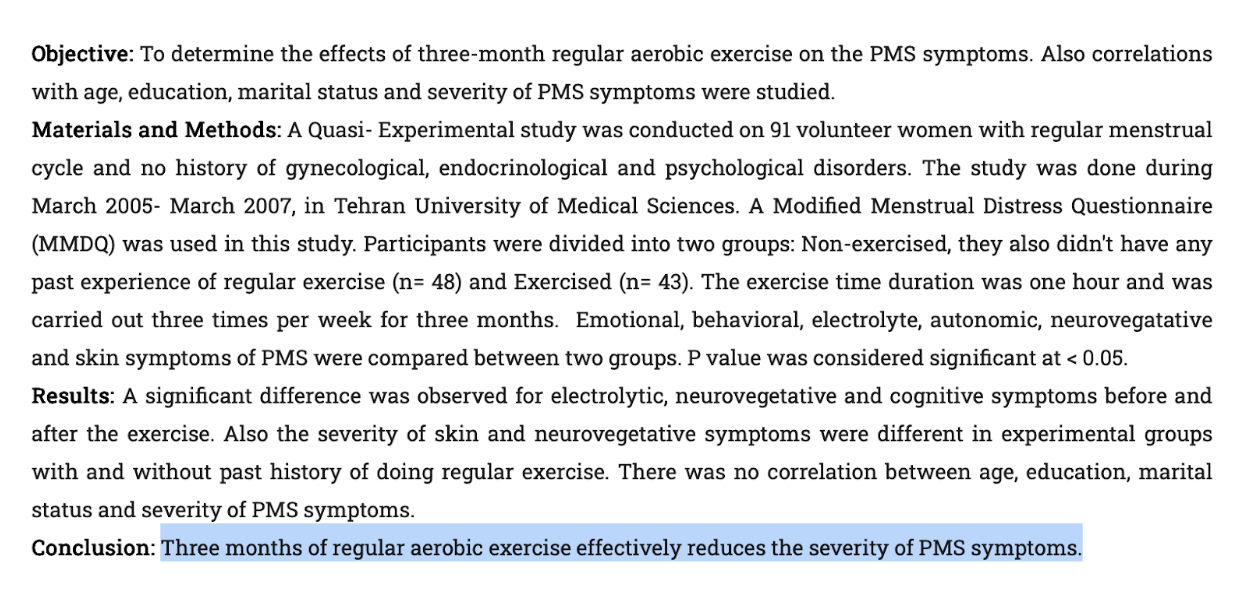
Here’s where it gets interesting.
Exercise isn’t just about burning calories or building strength.
During menstruation, it plays a regulatory role, balancing the autonomic nervous system, enhancing lymphatic flow, reducing prostaglandin buildup (a key contributor to cramps), and supporting mood through the release of feel-good neurotransmitters like dopamine and serotonin.
This doesn’t mean intense workouts are the answer. In fact, that’s not what your body needs in this phase. Instead, think low-impact, mindful movement.
Activities like walking in fresh air, restorative yoga, or gentle stretching offer the perfect blend of motion and recovery. They’re supportive without being depleting.
Let’s be clear—exercise and menstrual cycle rhythms are not opposing forces. They’re meant to work together, like a conversation between body and movement. The goal isn’t to ‘power through’ the pain but to use movement as a tool to manage it—intuitively, respectfully, and wisely.
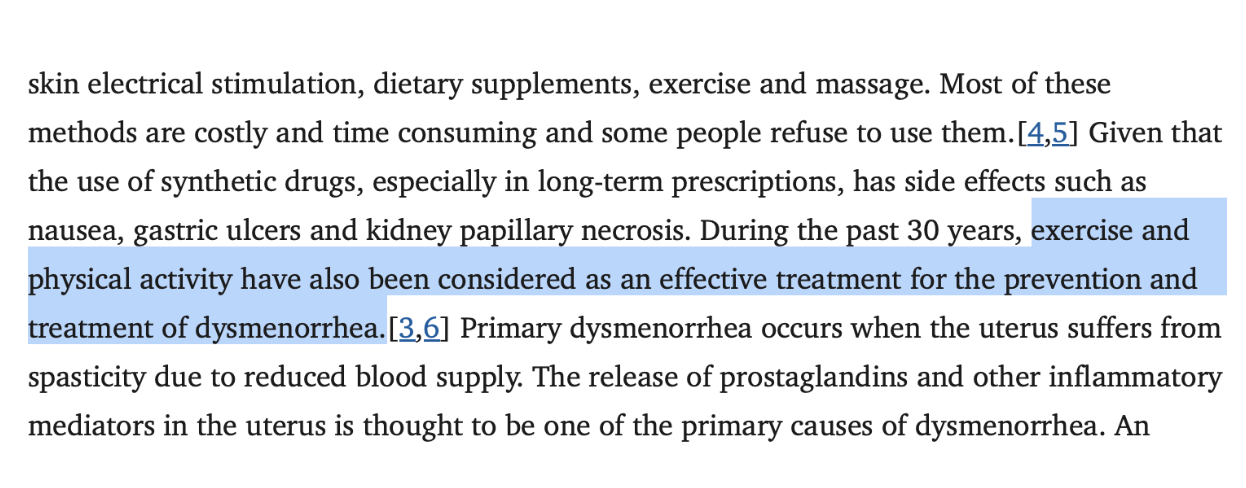
So, next time your period arrives and you’re wondering whether to stay curled up or move your body, remember this: your body isn’t broken. It’s simply in a different state, a phase that still thrives with thoughtful movement.
And when we stop seeing our cycles as limitations and start honoring their cues, we unlock one of the most powerful, natural ways to support our hormonal and emotional health.
Let’s Understand Your Monthly Inner Season
Nature doesn’t bloom all year round.
Trees shed, rest, bloom, and flourish in rhythm.
Likewise, a woman’s body isn’t designed to hustle through a flat, linear path. It’s cyclical—guided by a beautiful inner intelligence that changes week by week.
And when we align our movement to these internal seasons, our body doesn’t resist; it responds.
Let’s explore how each phase of your cycle mirrors a season and how your menstrual cycle workout can be tailored to meet your body where it is:
1. Follicular Phase = Spring (Approx. Days 6–14)
Your Inner Spring: Time to Rise and Reset
What’s happening inside: After your period ends, estrogen starts to climb, setting the stage for new beginnings. Energy levels begin to rise, and your brain becomes sharper and more focused. This is a phase of clarity, creativity, and motivation.
Workout Support:
This is the ideal time to reintroduce intensity. Your body is better equipped to handle physical stress and respond positively to training stimuli. You can do:
- Strength training and weightlifting
- Moderate-intensity cardio (cycling, dance, brisk walking)
- Skill-based workouts or trying something new
- Group classes or challenging fitness routines
2. Ovulatory Phase = Summer (Around Day 14)
Your Inner Summer: Peak Power & Performance
What’s happening inside: Estrogen peaks, and there’s a short surge of testosterone. You’re likely to feel confident, strong, and outgoing. Neuromuscular coordination and aerobic performance are naturally enhanced.
Workout Support:
This is your body’s performance sweet spot. Push yourself—if it feels right by:
- High-Intensity Interval Training (HIIT)
- Running, sprinting, or yoga
- Circuit training and heavy resistance workouts
- Competitive sports
A study published in the Journal of Applied Science found that maximal power output and strength peaked during ovulation due to optimal muscle recruitment and hormonal support.

So, what’s your excuse?
3. Luteal Phase = Autumn (Approx. Days 15–28)
Your Inner Autumn: Wind Down and Listen
What’s happening inside: After ovulation, progesterone rises. You may feel more introspective, with fluctuating energy and mood. Your core temperature is higher, and your tolerance for high-stress workouts begins to decrease.
Workout Support:
Yes, the luteal phase may increase fatigue and perception of exertion. This doesn’t mean you need to stop—it means your workouts should be smarter, not harder.
Shift to consistency and maintenance. The goal is to stay active without overexerting.
How?
Do the following:
- Moderate-strength training with lighter weights
- Steady-state cardio (elliptical, swimming, cycling)
- Yoga, barre, Pilates
- Nature walks or bodyweight movement
Think of this phase as preparing for rest. Be kind, not passive. Move to stabilize, not to push.
4. Menstrual Phase = Winter (Approx. Days 1–5)
Your Inner Winter: Retreat and Regenerate
What’s happening inside: Hormones hit their lowest. The uterine lining is shed, and the body focuses on renewal. You may feel tired, crampy, or slower, and that’s normal.
Workout Support:
Movement is still important, but it must be gentle, intuitive, and nourishing.
- Restorative yoga
- Light stretching and mobility work
- Slow walks in nature
- Deep breathing and somatic movements
Low-impact exercise during menstruation significantly reduces cramp intensity, improves mood, and supports circulation, likely due to endorphin release and reduced prostaglandin levels.

Disclaimer: Given the individuality of each woman’s physique, what suits one could not suit another. If you are using medication, have chronic problems, or have a medical condition, please speak with your doctor before changing your activity or lifestyle.
Your body is not the same every day.
And it was never meant to be. Tuning into your exercise and menstrual cycle isn’t about restriction—it’s about freedom. Freedom from guilt, pressure, and the outdated belief that pushing through every workout is the only way to achieve results.
So whether it’s strength in spring, power in summer, grace in autumn, or stillness in winter, let your menstrual cycle workout flow with your body’s wisdom.
Your 28-Day Menstrual Cycle Workout Guide
| Cycle Days | Phase | Recommended Movement |
| 1–5 | Menstrual | Gentle walking, yoga, stretching, and light breathwork |
| 6–13 | Follicular | Cardio, strength training, dance workouts, and dynamic yoga |
| 14–16 | Ovulation | HIIT, yoga, group workouts, and sprints |
| 17–21 | Early Luteal | Strength training, pilates, and cycling |
| 22–28 | Late Luteal | Restorative yoga, walking, mobility work, and low-impact pilates |
Gentle Reminders:
- Every cycle is unique. If yours is 25 or 35 days, adjust the window accordingly. The pattern remains the same.
- Listen to your body’s cues. Use this guide as a compass, not a command.
- Tracking helps. Journaling your energy, mood, and movement responses can help you personalize over time.
This isn’t about following a rigid calendar. This is about having a conversation with your body.
As much as science gives us frameworks, four phases, hormone maps, and performance windows, your body will always have the final say. And it speaks in whispers before it shouts.
In some cycles, you might feel like going for a brisk walk even on day 2 of your period. Other months, your follicular phase, the one usually associated with high energy, might feel sluggish, and that’s okay. True wellness isn’t found in ticking boxes. It’s cultivated through tuning in.
Why This Matters — Beyond Fitness
Exercise during your period and across the phases of your cycle is not just about getting stronger, leaner, or more toned.
When you begin to sync your movement with your hormonal cycles, you’re not just exercising. You’re responding to your body’s intelligence. You’re working with your biology, not against it.
Here’s why it matters:
- You support your cleanse pathways: Gentle movement during menstruation enhances lymphatic circulation and promotes the release of endorphins, which act as natural painkillers and mood boosters.
- You reduce chronic inflammation: Inflammatory markers like CRP (C-reactive protein) fluctuate with hormonal shifts. Engaging in movement aligned with your energy helps modulate inflammation rather than spike it through overtraining.
- You support metabolic and hormonal balance: Exercise can help regulate insulin sensitivity and cortisol rhythms, which are both closely tied to menstrual health.
How to Start Syncing Your Workouts with Your Menstrual Cycle
Small steps. Big shifts. Listen in. Align. Flow.
You don’t need to overhaul everything overnight. Menstrual cycle syncing is not a rigid fitness plan; it’s a gentle invitation to connect more deeply with your body.
Here’s how to begin:
1. Start tracking—beyond the dates.
Mark more than just when your period starts and ends. Tune into:
- Your energy levels
- Sleep quality
- Mood fluctuations
- How your body feels after movement
Apps can help, but a simple notebook or journal is enough. This builds body awareness, and it’s the foundation for syncing.
2. Match movement with how you feel, not just the calendar.
Yes, we gave you a 28-day menstrual cycle workout guide. But your body is the ultimate guide.
If you feel strong on day 2, go for it. If you feel flat in ovulation, slow it down. The best workout is the one your body asks for.
4. Listen more than you push.
The real work is in unlearning.
Especially the idea that rest = laziness, or that every day should be a high-performance day. Exercise during the period isn’t a contradiction. When done right, it’s a gentle form of medicine, without the side effects.
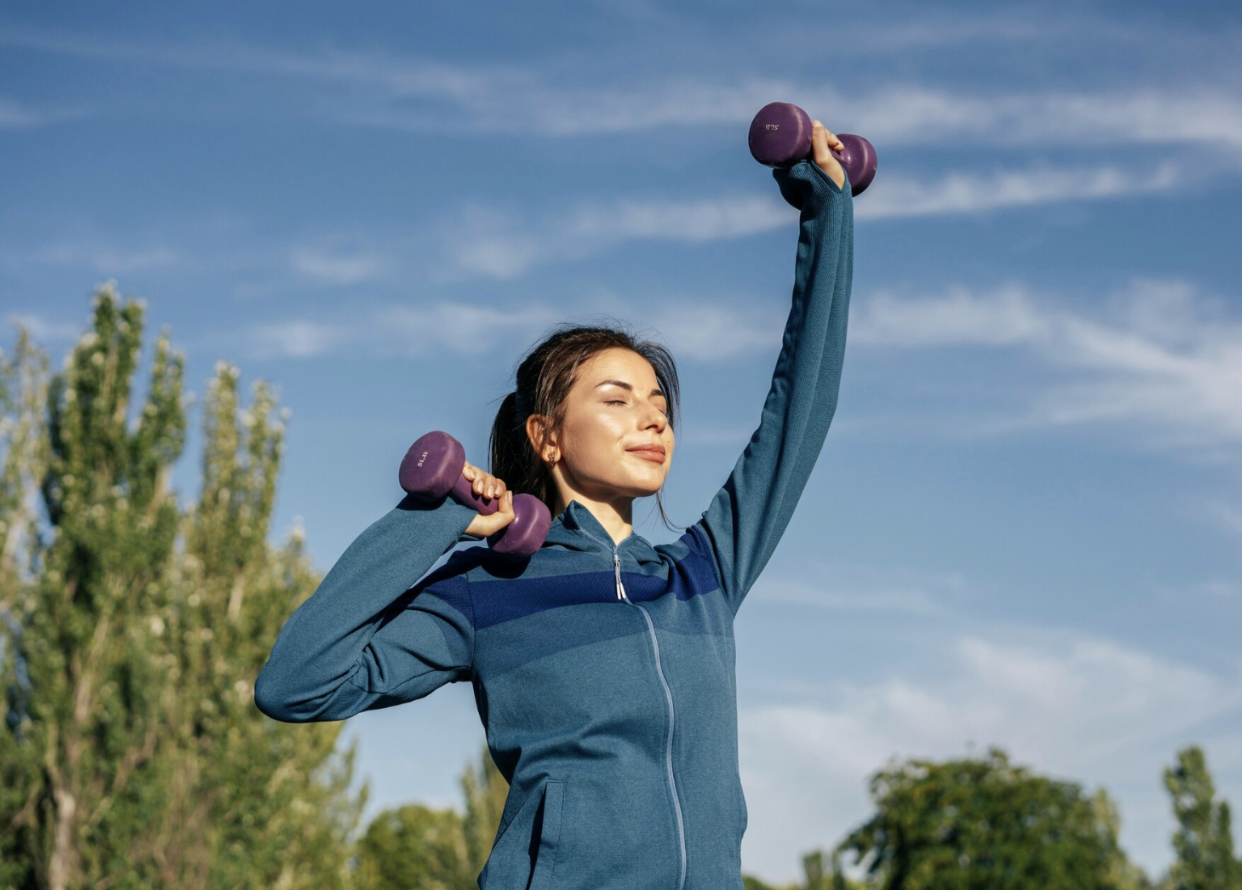
5. Stay curious, not critical.
Some months will be smooth, others won’t. That’s normal. Hormones, stress, travel, and food—all play a role.
This is a practice in observation, not perfection. You’re learning a new language: the language of your body.
How Nutrition, Movement & Lifestyle Together Support Your Cycle
Exercise during the period isn’t just about choosing the right form of movement; it’s about building a supportive inner environment that allows your body to move with ease, strength, and resilience across all phases of your menstrual cycle.
Your workouts don’t exist in isolation. The way you eat, hydrate, sleep, manage stress, and even the way you feel all influence how your body responds to movement.
You can bring these powerful lifestyle pillars together to support your menstrual cycle workout plan:
1. Nourishment: Feed Your Flow
Each phase of your cycle requires different nutrients to support hormonal shifts and energy levels.
- During your menstrual phase, focus on iron-rich foods like dark leafy greens, jaggery, beetroot, and dates to support blood replenishment.
- In the follicular and ovulation phases, bring in clean proteins, healthy fats, and complex carbs to fuel strength training and cardio workouts.
- As you move into the luteal phase, magnesium-rich foods (like pumpkin seeds, banana, and cacao) can ease PMS symptoms and support muscle recovery.
Cellular nutrition isn’t about calorie counting—it’s about giving your body what it needs to do the work it was designed to do, with less inflammation and more vitality.
2. Hydration: Support Body Cleanse and Circulation
Movement increases circulation. Hydration makes the circulation efficient.
Especially during exercise and menstrual cycle phases, staying hydrated helps reduce bloating, support digestion, and maintain electrolyte balance.
Add a pinch of rock salt or a squeeze of lime to your water post-workout. Drink water consistently, not just when you’re thirsty.
3. Sleep: The Hormonal Reset Button
You can eat well and move daily, but if you’re not sleeping well, your hormonal balance will suffer.
Research shows that poor sleep impacts ovulation, cortisol levels, and inflammation—all of which affect how your body performs and recovers after workouts.
Prioritize 7–9 hours of uninterrupted, deep sleep, especially during the luteal and menstrual phases, when your body needs deeper rest and repair.
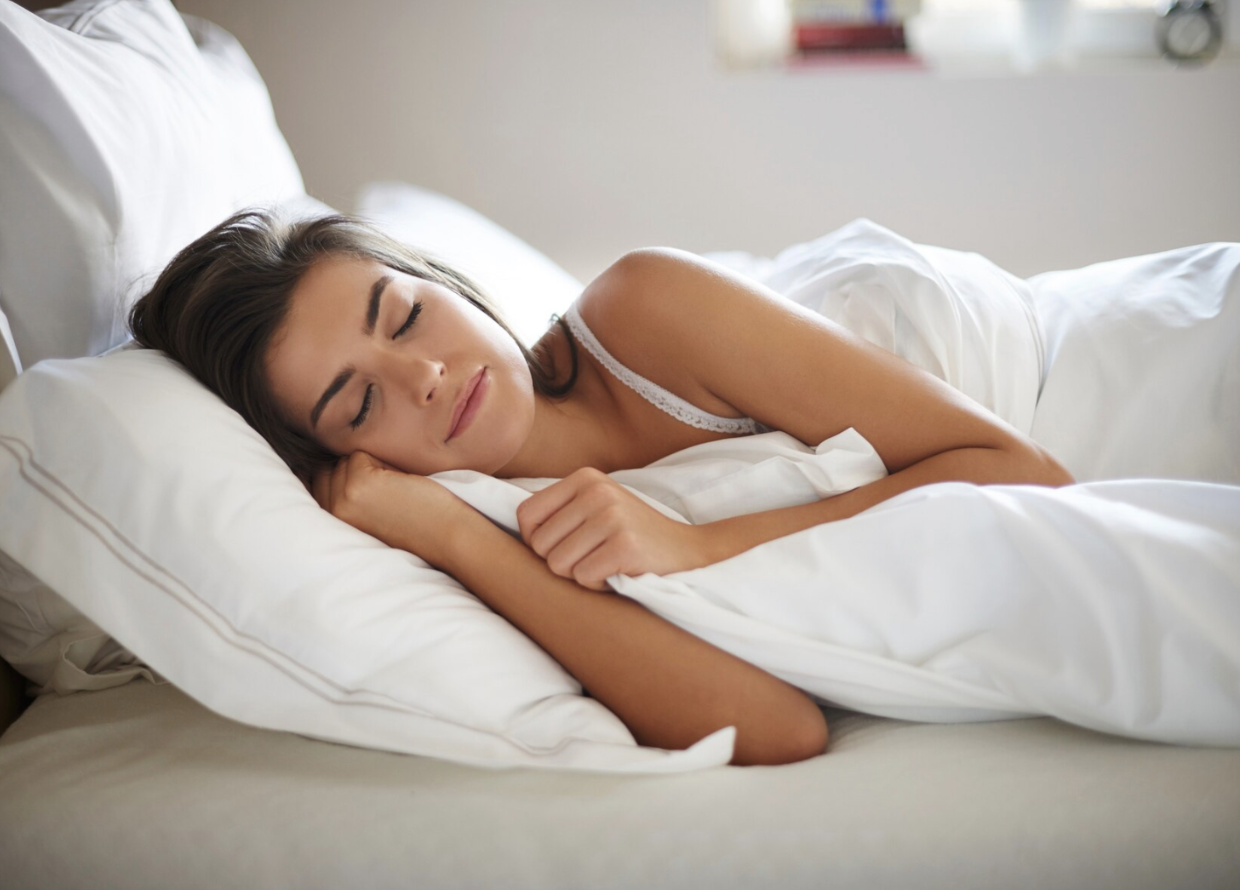
4. Emotional Wellness: Stress Affects Strength
How you feel emotionally often dictates how you move physically. Chronic stress increases cortisol, which directly impacts progesterone, insulin sensitivity, and recovery.
Whether it’s journaling, therapy, breathwork, or simply sitting in silence, emotional hygiene is as important as physical training.
Movement can be a way to process emotion, not escape it. Let your menstrual cycle workout be a container, not a punishment.
5. Spiritual Alignment: Your Cycle Is Not Random, It’s Rhythmic
You are not meant to be ‘on’ every day. Just as the moon waxes and wanes, your energy, strength, and clarity rise and fall.
Tuning into your spiritual self, through stillness, nature, prayer, or mindfulness, helps you move from force to flow.
Final Thoughts: You Are Not Meant to Push Through—You’re Meant to Flow
Let’s rewrite the story we’ve been told.
You don’t need to prove your strength by overriding your cycle.
You embody strength by moving in alignment with it.
Exercise during the period isn’t a no-go—it’s a ‘go gently.’ It’s an invitation to move in a way that supports, not depletes. To rest when needed, and rise when ready. To understand that the best kind of fitness is the one that listens to your body first and everything else later.
So, the next time your inner critic says,
“You’re being inconsistent…”
Remind yourself:
“No, I’m being cyclical. And that is not a weakness. That is wisdom.”
Disclaimer: This blog is for educational and informational purposes only. It is not intended as a substitute for medical advice, diagnosis, or treatment. Every woman’s body is unique, and what works for one may not work for another. If you have a medical condition, chronic symptoms, or are under medication, please consult your healthcare provider before making any changes to your exercise or lifestyle routine. Our intent is to empower you with knowledge so you can make informed, intuitive choices in partnership with your body and your healthcare professional.
If this blog resonates with you, and you’re ready to stop working against your cycle and start living with it, our Hormonal Care Program is here to support you.
It’s not about rigid rules or one-size-fits-all plans, but about understanding your body’s unique rhythm and creating a lifestyle that flows with it, through movement, food, rest, and emotional well-being.
Join us in learning how to work with your hormones—not against them—because when you align with your cycle, everything begins to shift.
Schedule a one-on-one consultation with our experts by calling us at 1800 102 0253 or emailing us at [email protected].
Team Luke
Start Your Wellness Journey
Feeling inspired to take the next step in your wellness journey? Connect with us to explore how our tailored programs can support your health journey. Your transformation is just a conversation away.



